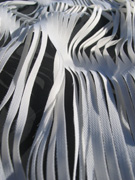|
Unit E 2004-2005 Staff Jonathan Dawes Guests
Scobie Alvis Students
Don Barker |
 Scissors: Paper: Stone Our aims for this year were to initiate architectural research at the intersection of real and fictional worlds. We primarily studied techniques of cutting, wrapping and carving space to develop spatial languages and rules with useful form-making and organisational analogies. Shibuyalove We visited Japan, examining the interwoven topological, temporal and programmatic qualities of unique urban conditions in and around Shibuya, Tokyo. We considered specific buildings according to their surface qualities, articulated ground planes or inclusive structural organisations, taking themes common to earlier studies. We also looked at signage and the status of the building as a sign, redefining the identity of the building skin in Omotesando and Ginza. This work culminated in an exhibition, Shibuyalove, held in the new AVA gallery. Scissors Cuts Paper... Through material experimentation and workshops we explored the latent qualities of materials by folding, splitting, expanding, casting and laminating. Our research focussed upon the crystallisation of tactile relations and unexpected geometries when concepts interact with one another: scissors cuts paper, paper wraps stone etc. Old Street: New Intensity
The landlocked transport interchange of Old Street Station provided the context for testing and a unit appreciation of the site through collective fieldwork and mappings. These formed the basis of a group appraisal document and a series of loose strategic agenda.
Heterogeneous Fabric The resolution of built fabric was based upon a redefinition of individual surface, material and volumetric interests forming a range of approaches and applications: |